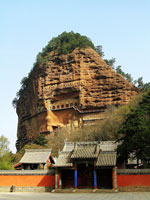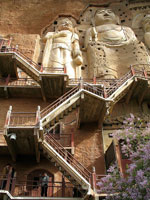Maijishan ("Wheatstack Mountain"), located on the northern side of the Qinling Mountain Range and at a height of 1742m above sea level, gets it's name from its giant, haystack-like shape.

Located southeast of Tianshui City in Gansu Province on a 142 meters high hill, it's fame arises not just from its appearance, but from the many Buddhist caves that are gouged into its southwestern face.
Work on the grottoes started in the late 4th century and continued through successive North Wei (386-534 A.D.) and Song (960-1279 A.D.) dynasties until the 19th century. This is the fourth largest area of concentrated Buddhist grottoes in China, after Dunhuang, Datong and Luoyang. The area around and on the mountain is one of the most beautiful sights in Gansu for both stunning natural, and impressive man- made, scenery.
The mountain, studded with caves and strapped by many winding walkways and spiral stairs, rises majestically from the surrounding heavily wooded slopes, so any visitor here with a bit of time on their hands could easily spend a few days hiking and admiring.
There are 194 existing caves, in which are preserved more than 7,000 sculptures made of terra cotta and over 1,000 square meters of murals. Earthquakes, rain and fire have damaged a large part of the caves and wooden structures.
The cave dwellings carved out of its soft loess, however, attain Maijishan its status as one of the most historically significant and sacred of the Buddhist cave sanctuaries. Cave sanctuaries in China range from single chambers to enormous monastic compounds that include halls for worship and teaching, living quarters for monks and travelers, and spaces such as kitchens and libraries. As way stations, cave sites like Maijishan played an important role in the development and dissemination of Buddhism into China.
On arrival at the sight the most prominent sculpture is the 16m Buddha that is carved high up on the mountain. The grottoes, all packed together on the sheer, rocky cliff faces below and above this, look from afar like chambers of a gargantuan beehive.
On ascending the mountain, the grottoes are divided into two sections, the western and eastern, since the central section was almost completely destroyed by an eighth century earthquake.
The western section is probably the better, with statues and other Buddhist articles dating mainly from the Northern Wei Dynasty to the Tang (618-907 AD). Just ascending the mountain, on winding, rickety walkways and spiral stairs, with the wooded mountain panorama below, is a breath of fresh air for even the most unconvinced China traveler.
The Grottoes are not the end of a comprehensive trip here. 15m above the giant clay Buddha, on the eastern slope, is the Seven Buddha Pavilion (Qifo ge), a typical Han Dynasty (206 BC-220 AD) construction of interesting architectural value. Recent years have also witnessed the opening of a few of the dilapidated temples around the mountain making the area good for hiking. The best place for such activity is in the Botanical Garden. This is situated in front of the mountain, reached by taking stairs to the right, down the road before the grottoes' ticket office.
The Buddhist iconography of the Northern Wei and Western Wei Dynasties are simple, like those of the earliest caves at Tunhuang. The most common theme is a seated Buddha flanked by bodhisattvas and other attendants, or sometimes by monks or lay worshippers (See Fig. 5).
Standing guard near the doorways of most Wei Period caves are pairs of dvarapala and the four Heavenly Kings (lokapala) (See Fig. 8). The monk disciples of Ananda and Kasyapa, accompanied by other lesser monks and nuns, stand in attendance in several other caves.
Most of the imagery from the Northern Chou and Sui Dynasties has been destroyed over time due to the rough climate of Gansu Province. Restored Sui Dynasty imagery includes the Buddha Triad (Buddha of the Past, Present and Future) and the Buddhas of the Ten Quarters.
Buddhist art of the Sung Dynasty found in the Maijishan caves include one cave where the central seated figure is a bodhisattva, flanked by very feminine bodhisattvas. In another cave, where earlier ascetic figures of Ananda and Kasyapa would have stood, lies a pair of charming young ladies who are not even nuns.
Over the years, from the Wei to Sung Dynasties, the imagery of Maijishan shifted emphasis from the Buddha to the bodhisattva, an important characteristic of later popular Buddhism in China.
The way that these pieces of Buddhist art were created is also important since it represents the common methods of sculpture creation in China and the influence that religion has on sculpting methods. Early craftsmen and patrons took with orthodox iconography; however, a shift of iconography was also accompanied by a shift in method. Except for any sandstone figures which were brought into the caves from elsewhere, all the sculptures of Maijishan were made of clay.
The seated Buddha figures in the caves were, for the most part, modeled solid in clay, and then painted. The clay was applied in several layers, and a rough wooden armature was used to support projecting arms.
Some of the standing figures such as bodhisattvas, worshipers and monks are solid; others are hollow-molded over a wooden armature. The head in most cases was made separately and inserted into a socket between the shoulders. The importance of these sculptures stems in the very fact that it is modeled in clay, which expresses most directly the feeling of the craftsman as he manipulates the highly plastic medium with his hands and fingers.
Ultimately, Maijishan Mountain had transformed Buddhist image-making from a foreign sculptural art into a native one. Along with the imagery of Buddhism, the ideas of Buddhism were brought from India to China. Some of the finest clay sculpture of Chinese art lies within the caves of Maijishan.
The abundance of clay sculptures at Maijishan makes it possible to consider clay sculpture in the history of Chinese art. This diminutive mountain, only 142 meters tall, through all of its effects, has had an extremely important impact on the Chinese culture.

LOCAL CUISINES OF TIANSHUI
Tianshui is not really known for its own specialty cuisine, but you can find many varieties of the cuisine of Gansu here. The best of these include Lanzhou Beef Noodles (Lanzhou lamian), Zhangye Fish Balls (Cuo yuzi) and Dunhuang Saozi Noodles (Saozi mian). Cuisines from further afield are also prevalent and travelers should try the Xi'an Yangrou Paomo, Xinjiang kebabs (Kao yangrou), roast lamb leg (Kao yangtui), stewed lamb (Men yangrou) and beef hotpot (Niurou huoguo), that can be found on most stalls and restaurants about town.
There is one specialty that the Tianshui locals are fairly proud of: a yellowish pastry type substance made almost wholly of flour called Mianpi. These balls are simply made by mixing flour and water, forming the product into a thick pancake structure, and then boiling this. The flavour of these pieces are made by the addition of a variety of seasonings. The best place to sample Mianpi is in Jianchang, a local fair within the city center.
The area around Tianshui is also known for its productive soil, and there is an abundance fo fruits that could take your fancy. These are still all mostly seasonal, and include such exotica as peach, apricot, muskmelon and refreshingly juicy watermelon.
Food stalls and semi decent restaurants can be found scattered about town. For those staying in the Tianshui Hotel, on 5 Yingbin lu, there is probably the best restaurant in town within, and some decent ones in the nearby locale. For those spending a few days in the Maijishan area there are a few restaurants and a scattering of stalls on or near the mountain. The Maiji Hotel also has its own restaurant.
Climate of Tianshui
Located in the southeastern part of Gansu Province and the southern part of the Yellow Soil Plateau, Tianshui is 1,100m above sea level. The city has a semi-moist, temperate climate. The annual average temperature is 11.5°C, with July being the hottest month and January the coldest. The annual precipitation is between 550mm and 770mm, mainly falling during the rainy season from June to September.
Monthly Average Temperature in Tianshui
| Month | Jan. | Feb. | Mar. | Apr. | May | Jun. | Jul. | Aug. | Sep. | Oct. | Nov. | Dec. |
| Average Temperature (°C) | -0.6 | 0.2 | 6.3 | 11.7 | 17.7 | 21.1 | 23.3 | 21.7 | 16.3 | 11.3 | 3.9 | -1.8 |



